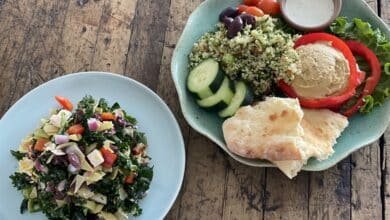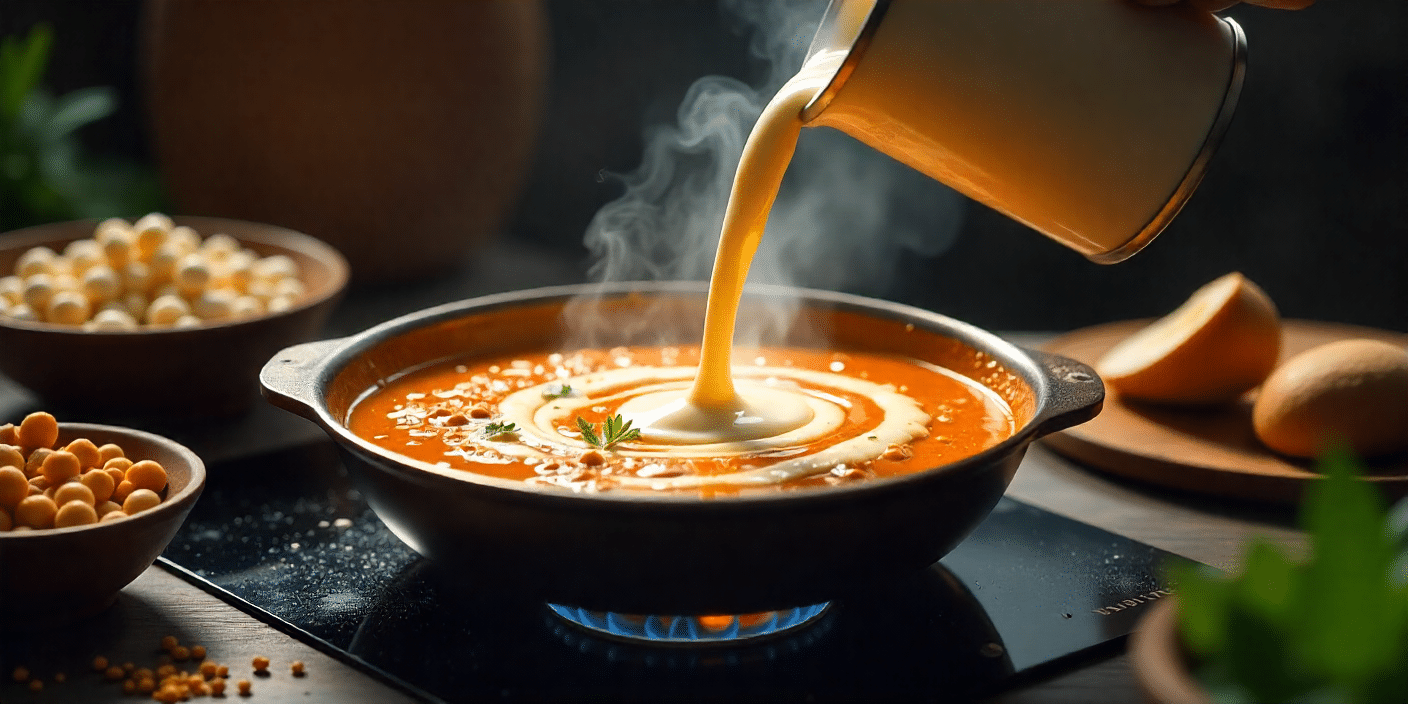
The best recipe for Indian chickpea curry with coconut milk
Indian chickpea curry with coconut milk is a vegetarian dish rich in aromatic flavors and spices, inspired by traditional Indian cuisine, and characterized by a perfect balance between creamy textures and spicy and pungent flavor . This dish is an ideal choice for those looking for a nutritious, filling, and easy-to-prepare meal, without the need to use animal ingredients.
This recipe consists mainly of cooked chickpeas, which are an excellent source of plant-based protein and fiber, and is cooked in a rich sauce made with creamy coconut milk and authentic Indian spices such as turmeric, cumin, ground coriander, ginger, garlic, and garam masala. Mashed or chopped tomatoes add a mild sour flavor, while coconut milk gives a smooth texture and a soothing, balanced taste.
One of the advantages of this curry is its ease of preparation, as it can be prepared in just one bowl in less than 30–40 minutes, making it ideal for a quick weekday dinner or as a nutritious meal served to vegetarian guests. It is also gluten-free and suitable for people on a vegetarian diet (Vision).
What is Indian Chickpea Curry with Coconut Milk
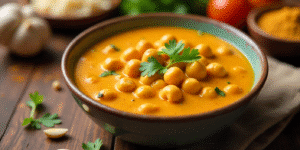
Indian curry with chickpeas and coconut milk is a vegetarian dish rich in aromatic flavors and famous Indian spices, prepared by cooking chickpeas in a rich, creamy sauce made from coconut milk, with a mixture of spices such as turmeric, cumin, coriander, ginger, and garlic. Tomatoes add a balanced acidic touch, while coconut milk gives the dish a smooth texture and rich taste that blends sweetness and spice.
read more : Healthy lunch ideas for work to lose weight
Ingredients You’ll Need
Main Ingredients
Boiled chickpeas, coconut milk onions, Garlic Ginger Tomatoes, Ground cumin, Ground coriander, Turmeric Jaram Masala Vegetable oil or coconut oil salt
Optional Add-ins for Extra Flavor
You can add many components, and here are some suggested additions, explaining the feature of each addition. Chopped fresh coriander (to give the dish an aromatic and refreshing touch when serving) Lemon or lime juice (to add balanced acidity and refreshing flavor ) , Spinach or green cabbage (to increase nutritional value and attractive color) , Sweet potatoes or chopped potatoes (to enhance texture and make the dish more filling) , Grated coconut (to increase the natural coconut flavor) , Vegetarian milk or yogurt (to reduce the heat of the curry and make the texture more creamy) , Green peas (to add a touch of sweetness and varied texture) , Fresh green curry or additional curry powder (to further complicate flavors)
Ingredient Substitutions
When preparing Indian curry with chickpeas and coconut milk, you may sometimes experience a shortage of certain ingredients or a desire to replace them for health or preferential reasons. Fortunately, many ingredients can be easily replaced without significantly affecting the flavor and quality of the dish.
For example, if you don’t have boiled chickpeas, you can use red lentils or green lentils as an excellent alternative, as they both give a similar texture and distinct flavor with an increase in the amount of protein. As for coconut milk, you can replace it with soy milk, almond milk, or even oat milk, but you should know that these alternatives may not add the distinctive coconut flavor that the original milk gives.
For onions, if regular onions are not available, green onions (green onion balls) can be used which give a lighter, less intense flavor. If fresh tomatoes are not available, tomato paste or mashed canned tomatoes can be used, taking care to dilute the paste if it is too concentrated.
How to Make Indian Chickpea Curry with Coconut Milk
Step 1 – Prepare the Vegetables

Start by preparing the vegetables needed to prepare Indian curry with chickpeas and coconut milk. Peel and finely chop the onions, as onions are an important base that adds deep flavor to the sauce. Next, peel the garlic, mash it well, peel the ginger and grate it fresh for a distinctive and aromatic flavor that distinguishes the dish. Then cut the tomatoes into small pieces or use tomato sauce if you prefer, as tomatoes add acidity and color to the curry. Make sure to prepare all of these vegetables before you start cooking to make the process easier and get a consistent result in taste.
Step 2 – Simmer the Chickpeas in Spices
After preparing the vegetables, comes the step of cooking the chickpeas with spices that give the dish its distinctive flavor. In a saucepan over medium heat, heat a little vegetable or coconut oil, then add the chopped onion and stir until translucent and golden.
Then add the crushed garlic and grated ginger, and stir for a minute until fragrant. Then add spices such as cumin, coriander, turmeric, and crushed red pepper to taste, and continue stirring for a few seconds until the spice flavors activate.
Next, add the boiled chickpeas to the pot and stir well with the spices, then add the chopped tomatoes or tomato sauce. Add an appropriate amount of water or vegetable broth to cover the ingredients, and let the mixture boil over low heat for 10 to 15 minutes until the flavors blend and the sauce thickens.
Step 3 – Add Coconut Milk for Creaminess
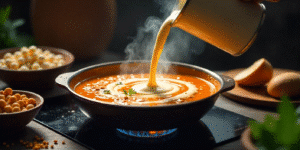
After the chickpea and spice flavors have combined and the sauce has thickened slightly, it’s time to add coconut milk, which gives the dish a rich, creamy texture and a distinctly delicious flavor. Gradually pour the can of coconut milk over the chickpea and spice mixture, stirring gently to combine the ingredients evenly.
Reduce the heat to low and let the curry cook for another 10 to 15 minutes, until the flavors blend well and the texture thickens to suit your taste. Coconut milk not only adds a creamy texture, but also helps soften the intensity of the spices, making the dish balanced and endearing to everyone.
At this point, you can taste the dish and adjust the salt or add more spices as desired.
Step 4 – Garnish and Serve
After the curry is cooked and acquires a creamy texture and homogeneous flavor, remove the pot from the heat and prepare to serve the dish in an attractive way. Sprinkle chopped fresh coriander leaves over the curry to add a touch of bright green and a refreshing flavor that enhances the taste of the dish.
You can also add some lemon slices on the side, as each person can add lemon juice according to their taste to increase acidity and balance the flavor.
Indian curry with chickpeas and coconut milk is served with cooked basmati rice, Indian naan bread, or even with quinoa. Serve the dish hot and enjoy a nutritious vegetarian meal full of authentic flavor.
read more :Easy recipe for creamy shrimp zucchini pasta with zucchini
Tips for the Perfect Chickpea Curry
How to Adjust Spice Levels
Spices are an essential part of the flavor of Indian curry, but not everyone tolerates the same level of heat or strong flavor. Here are effective ways to adjust the spice level. Reduce the amount of chili pepper: Whether it’s fresh pepper or red pepper powder (chili), start with a small amount and you can increase it later. Use coconut milk
How to Thicken or Thin the Curry
Using a spoon or masher, mash a small amount of chickpeas inside the pot. This adds a natural texture without the need for any additives. Let the curry boil uncovered over low heat, until part of the liquid evaporates and the flavors concentrate.
Balancing Flavors
Adjust the taste whether you want to get a hot or sour taste as desired
Variations You Can Try
South Indian Style with Curry Leaves
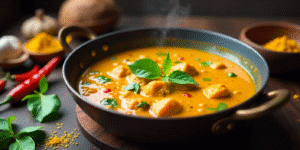
If you want a deeper, more flavorful experience, adopting the South Indian style is a great option. This method is known for using fresh curry leaves, roasted spices, and a touch of coconut oil, giving the dish a unique earthy and aromatic flavor.
Adding Spinach or Kale for a Healthy Twist
For those looking to enhance the nutritional value of chickpea curry without affecting the authentic flavor, adding spinach or kale (curly cabbage) is an excellent option. These two ingredients add a high dose of iron, fiber, and antioxidants, as well as their attractive green color that adds visual beauty to the dish.
Chickpea Curry with Vegetables
If you’re looking for a vegetarian dish that’s filling, rich in protein and fiber, and full of color and flavor, a vegetable chickpea curry is the perfect choice for you. Inspired by traditional cuisine, this Indian dish is one of the easiest and most delicious dishes that can be prepared in a short time using ingredients available in every home.
Serving Suggestions
Best Side Dishes for Chickpea Curry
Some suggestions for side dishes White or basmati rice naan or rotted bread Cucumber salad with milk
How to Serve for a Party or Gathering
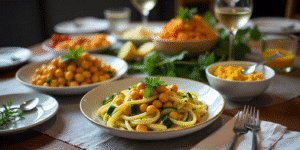
Use a large table and distribute the ingredients separately so guests can configure their dishes to their liking: A large plate of warm chickpea curry. Bowls of basmati rice. Different types of bread such as naan and roti. Side salads like raita and mint cucumber salad. Indian pickles and additional spices (such as chili, yogurt sauce, lemon slices).
Storage and Reheating
How to Store in the Refrigerator
Allow the curry to cool completely, then transfer it to airtight containers, put a label with the preservation date, you can preserve it for up to 4 days.
Freezing Tips
Never put hot food in the freezer, let the curry cool completely to room temperature (preferably within 60 minutes of cooking), use high-quality, airtight plastic containers or freezer bags, and finally write down the freezing date and content of the container.
Best Way to Reheat Without Losing Flavor
On the stove (best way): Pour the curry into a non-stick saucepan. Heat over low to medium heat. Add a little water or coconut milk if it seems too thick. Stir constantly to prevent sticking or burning, especially from the bottom. When it starts boiling lightly and reaches a temperature of approximately 75°C, it is ready
Nutrition Information
Calories and Macronutrients
One serving of chickpea curry contains approximately 280 to 350 calories, depending on the type of oil used and the density of coconut milk added. Carbohydrates constitute the largest percentage of calories, amounting to about 30 to 35 grams per meal, coming mainly from chickpeas and some vegetables such as potatoes or carrots, if added.
Plant protein, which is an important nutrient especially for vegetarians, ranges from 9 to 12 grams per serving, and comes mainly from chickpeas. This amount is good for supporting a feeling of fullness and helping build muscle.
Regarding fat, the amount in a serving ranges from 12 to 18 grams, and this directly depends on the amount and type of coconut milk used. Whole milk contains a high percentage of saturated fat, which may reach 9 to 12 grams of saturated fat per serving. Although saturated coconut fats differ in composition from animal fats, moderation in their consumption is preferred.
On the other hand, the dish contains an excellent amount of dietary fiber, ranging from 8 to 10 grams per serving, which enhances digestive health and helps regulate blood sugar levels.
As for sodium, it varies greatly depending on the amount of salt or ready-made curry paste used, but it often ranges between 400 to 600 mg per serving, which is considered average and appropriate unless the person suffers from high blood pressure.
Health Benefits of Chickpeas and Coconut Milk
If you are looking for a delicious meal that combines rich taste with high nutritional value, a combination of chickpeas and coconut milk is an ideal choice. This vegan duo combines plant-based protein, fiber, and healthy fats, making it a cornerstone of many vegan recipes, especially in curry dishes.
Frequently Asked Questions
Can I Use Canned Chickpeas Instead of Dried
Yes, you can easily use canned chickpeas instead of dried chickpeas in this Indian curry recipe with chickpeas and coconut milk. In fact, canned chickpeas save a lot of time because they do not need to be soaked or boiled, and can be used immediately after filtering and rinsing well to remove any preservatives or metallic taste resulting from the can.
What Can I Use Instead of Coconut Milk
If you don’t prefer using coconut milk in your Indian hummus curry recipe, there are several alternatives that can give the dish a creamy texture and delicious taste without significantly affecting the overall flavor.
Is This Curry Gluten-Free and Vegan
Yes, coconut chickpea curry is gluten-free and vegan (Vegan) if you stick to the traditional basic ingredients

